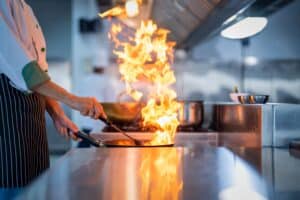The KōL Izakhaya menu is so authentic to the culture that Japanese customers keep coming back.

There are rarely Japanese restaurants that are authentic to the culture and cuisine, as some restaurants offer crossovers when it comes to Asian food, where you will find sushi at a Chinese restaurant and chow mein at a Japanese eatery.
However, you won’t see that at KōL Izakhaya in Hyde Park Corner, Johannesburg. Everything from the name, to the symbol, the interior design and the cutlery have been meticulously thought of.
KōL is the Japanese interpretation of the kanji symbol for ‘coal’ and ‘izakaya’ in Japan means tavern, good drinks and delectable dishes that are shared and enjoyed among friends and colleagues, says restaurateur Viron Christopher.
He recently took us on a tour of their new restaurant KōL, explaining every detail of this beautiful eatery that could easily fit in any Japanese landscape.
Robata
The idea of the restaurant is the purpose of a workflow; having separate sections which include a private dining era, the bar, Robata station (coal station) and the sushi bar. There are plans to expand the restaurant to have business offices in the KōL building and a Japanese sauna with membership services.
ALSO READ: The Insights Restaurant at Sanctuary Mandela serves up a flavour punch
The centre of KōL brings people close to the fire – something similar to South Africa’s braai – with the robata grill in the middle of the restaurant. Robata is short for ‘robatayaki’, which translates to ‘fireside cooking’ in Japanese cuisine. The cooking technique is widely used in street food in Japan.
“The coal enhances the flavours because of the moist and the drips feed back to the coal without the rich smokiness but produce a pure flavour. Our coal is low smoke and low ash coal,” Christopher says.
The distinct aesthetic of the exterior in KōL is known as shou sugi ban – the burning of wood. Christopher says it is an old technique to waterproof homes with wood and oil, protecting houses from the elements, “keeping them warm in winter and cool in summer, because of the absorption.”
Renowned architectural designer Tristan du Plessis was given a thorough brief for the restaurant and gave them more than expected.
Watch: Inside KōL Izakhaya
KōL Izakhaya menu
Executive chef Mia Muto from Japan has travelled with Christopher to his home country to soak up as much knowledge about the culture and food.
You can definitely tell in many ways how they have kept the authenticity. They export real wasabi paste ground from Wasabi tree, grow their own shiso – a Japanese herb that has a mint and basil flavour – and use wasabi salt made from horseradish powder.
“It is not a take of contemporary Japanese, it is respecting the ingredients and not trying too hard to make them something that they are not. We use some of the ingredients with our interpretations, with our sushi we keep it simple, it’s not mayonnaise,” Christopher explains.
Hearing this was music to my ears, the sushi is simple and stays true to the original with just sushi rice, avocado, freshly cut seafood (tuna, salmon) and the best wasabi. They do have options of original soy sauce and gluten-free soy sauce which tastes just as good.

The Robata station (fire grill) there is an array of meat choices. Trying the chicken hearts (Hatu), chicken thigh (Nagima) which were soft and tender, chicken meatballs (tsukune) and the wagyu was the best experience. The wagyu is one of the drawcards, a culinary experience because you can cook the wagyu yourself over the portable shichirin grills.
The dumplings are definitely worth trying, with the soft dough that is perfectly cooked. The spinach and cream cheese with onion was my favourite.
Japanese people are known for perfection and mochi is a bucket list item for many. Mochi is hard to come by and has a cult-like following.

Mochi is a thin layer of sweet dough made from rice flour, that is wrapped around silky smooth ice cream. The ice cream was top notch with beautiful flavours inspired by sesame paste, charcoal, matcha and berries.
The Japanese-inspired crème Brulees were the winners, particularly the matcha flavour which was divine.
On the mixology menu, the theme of the culture continues in the cocktails and there is a water menu. The water menu is a selection of natural water from around the world, including the Arctic and Mountain Falls in the Western Cape. Water has never tasted so good!
For Christopher, the response has been phenomenal since they opened their doors a month ago.
“Our Japanese customers are returning because they getting the right type of ingredients and it’s taking them back home.”






